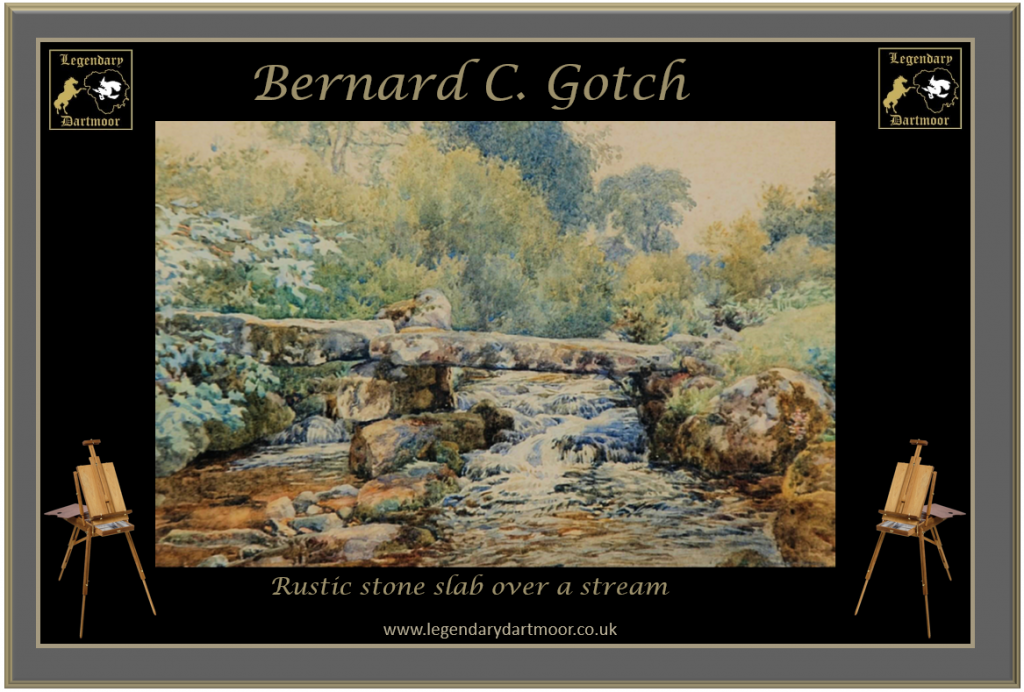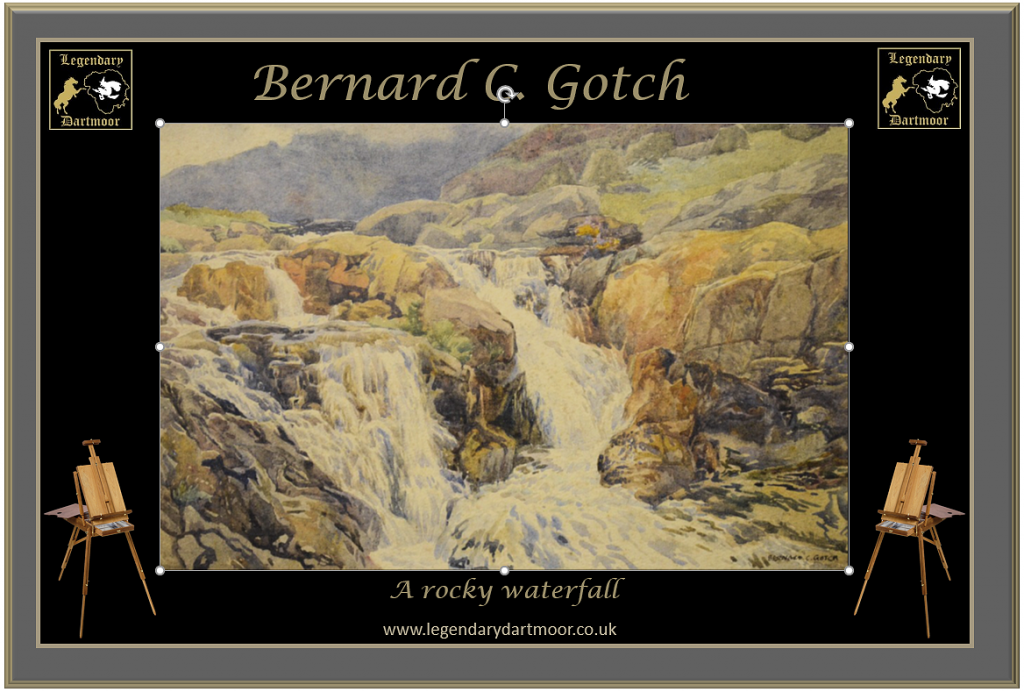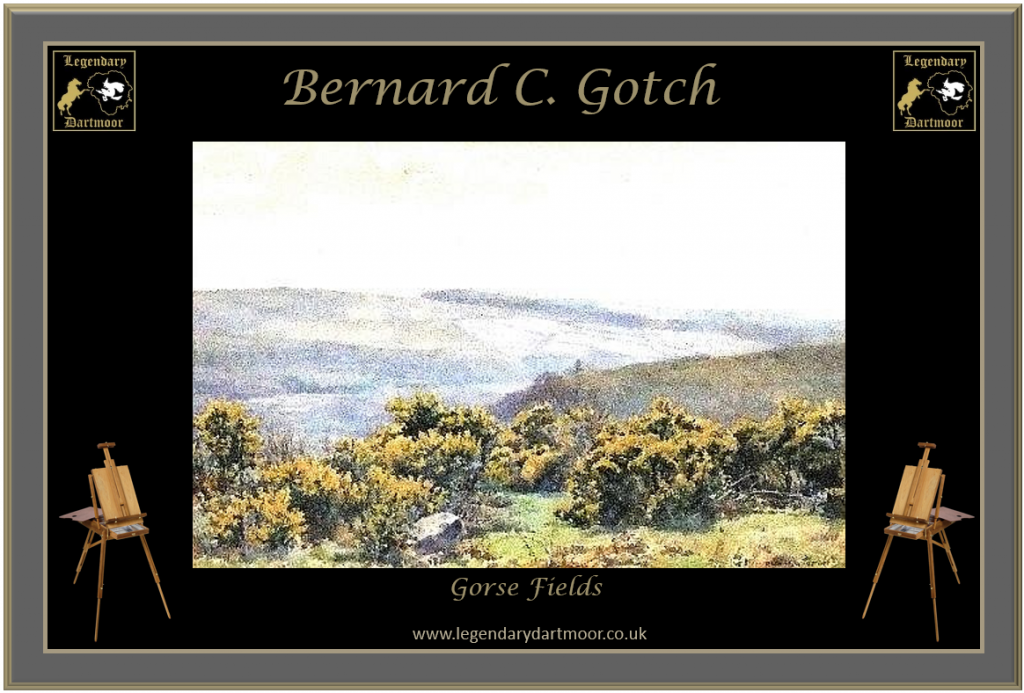
Ask most people to name a Dartmoor artist and on the list would probably be the Widgerys, Brittan, Rowden, Morrish, Tozer, and Sherrin to name but a few. But I wonder if Bernard C. Gotch would even appear in that salubrious hall of fame? In Brian le Messurier’s book ‘Dartmoor Artists’ he notes; “Though he exhibited 26 times at the Royal Academy, little is known of Bernard Cecil Gotch (1876 – c.1940). He was born and educated in Winchester and moved to Bath. His favourite territory was the River Dart.” – p.75. Apart from the fact that Gotch died in 1963 not c.1940 I think its about time he and his talents were brought out from the realms of obscurity.
Bernard Cecil Gotch was born on 17th May 1876 at Chilcombe near Winchester. He began his artistic pursuits as a student at the Winchester School of Art and later as a teacher. In 1914 Gotch married his wife, Mary Fox, and settled down in Winchester where he embarked on a series of water colours in and around that city. Whilst embarking on his artistic career both he and his wife who was a violinist carried on teaching in order to supplement their income. In 1921 the Western Morning News published the following article:
“Among many artists who may claim to have discovered Dartmoor – though many of its rarest beauties are still uncharted land – one claim may be fairly credited to M.r Bernard C. Gotch. Dartmoor is a discovery of his. Cousin of Mr. T. C. Gotch, of Penzance, vice-president of the Royal West of England Academy, and himself an artist of distinction. Mr Gotch planned in the Spring of last year (1920) a sketching tour of the Devon Moors. Caught by the lure of it, he prolonged his stay from weeks to months. He returned home to hear again the call of art in the Autumn, and having seen Dartmoor in the golden glories of the fading year, he found his fate. A second spring visit this year (1921) satisfied him that he had at last begun to understand something of its great fascination, and he became one of the unique company of Dartmoor artists.”
In the summer of 1921 the fruits of his labours were displayed in an exhibition in the galleries of Messrs. Harris and Son in George Street in Plymouth. All in all sixty six of his works were on display and by all accounts the exhibition attracted a great deal of interest, both from art lovers and Dartmoor enthusiasts. It was said at the time that the sheer number of works were remarkable considering the short time scale taken to produce them, again some critics considered the effort as ambitious which for some artists would have attracted criticism. The article then went on to say:
“For it is obvious that the one-man show is a severe test for any artists. Whilst the value and individuality of his work are emphasised, so also are repeated his tricks of style and errors in composition and tone. Mr. Gotch comes quite well through this ordeal. We have seldom seen in one man’s interpretation such an all-round appreciation of Nature in her varying moods. Each picture is itself a definite and careful study made on the spot. Mr. Gotch is not tempted by the facilities of body colour of tempers; he is an artist in clean, pure, direct water-colour.”
The majority of Gotch’s works are centred around the southern moor with locations varying from Shaugh Prior to Princetown and Dartmeet to Yelverton. Whilst embarking on his artistic tours his first home base was a farmhouse at Brisworthy and later at another farm near Sheepstor. There can be no question that during this time he covered many moorland miles in search of his perfect subject. Even harder it must have been difficult, having found his subject, to obtain the ideal light and weather conditions in which to portray them. What made Gotch’s task even more difficult is that the majority of his works were painted in-situ as opposed to in a studio. Some of Gotch’s works portray early sunrises which would suggest that he was no ‘stay-a-bed’ and ventured forth at times when other artists would be adverse – no gain without pain.
The art critic for the Western Morning News subjected some of his paintings to scrutiny, saying:
“In “On the East Dart” we have a good instance of the direction of his work. It is a delightful sketch of the bend of the river, flowing round a wall-crowned with cool foliage. A few substituted rowan berries complement the delicious greens. “Blackaton Cross” demonstrates a fine knowledge of perspective. In front of a wide road stretches uphill, dips, and ascends. One can almost follow the modern motor (mercifully left to the imagination) racing up and down this moorland road. At the side of the road is a granite cross, perfect in colour and in form, with the surrounding landscape so delineated that one feels that one can walk round and around the cross. There are many delightful pictures of Sheepstor. In one we have the view from the Golf Links across the Meavy valley, with church and village nestling in the hollow, and the tor inspiring prospect. “Sheepstor Church” makes one hope that Mr. Gotch will continue his study of moorland churches. In “Granite and Gorse” it is evident that both phases of the subject have been faithfully studied not in the studio but on the spot.”
Other works included in the exhibition were “Dartmeet Bridges”, “The Hut Circle, Ringmoor”, “Langcombe Valley”, “Legis Tor Mire”, “The Plym Above Shaugh Bridge”, “Burrator at Dawn”, several depicting “Burrator Lake”, namely reservoir, “A Rocky Waterfall”, “Gorse Fields”, and “Rustic Slab Over a Stream”.
Finally the critic added; “If we might add one word of practical criticism. most artists overpower their work by too broad expanses of white mount. The aggressive suggestion of 66 brilliantly white settings to schemes of delicate tone and colour is overwhelming. A scheme of neutral tints would both form more appropriate environment and give the untrained eye an uninterrupted chance to absorb the picture.”
By all accounts the exhibition was a great success and many of the pictures were quickly reserved for sale and attendance was far better than could have been possibly hoped for. Eventually Mr. and Mrs. Gotch were torn away from Dartmoor and moved to London. It was here that Gotch set up his studio which was close to the Tate Gallery. Further exhibitions followed at Lincoln Inns and the Fine Art Society. Around this time Gotch concentrated on displaying his skills for depicting architectural buildings which lead to a commission to illustrate a book about the public schools of England. For whatever reason this project was never completed although some of the works for the proposed book where shown at an exhibition at the Fine Art Society in 1927. Several of his works won the accolade of exhibitions at the Royal Academy. In 1925 the Gotch family moved to Oxford where again his work focused on the exterior and interior architectural marvels of Oxford’s colleges which won him regular exhibitions in the lecture rooms of Oriel College. In 1952 Bernard C. Gotch received an honorary M.A from the university of Oxford and eleven years later passed away in 1963.
 Legendary Dartmoor The many aspects past and present of Dartmoor
Legendary Dartmoor The many aspects past and present of Dartmoor



